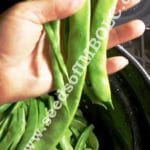Bean Types
All beans belong to the legume family. Shell beans are grown for their protein-rich seeds, which are eaten both fresh and dried. Snap beans (Phaseolus vulgaris) are cultivated mainly for their pods.

Bush types are generally self-supporting while pole type beans have twining vines that require support.
Runner beans (Phaseolus coccineus) are pole beans (meaning they climb), although runners need cooler growing conditions.
Snap beans are also known as green beans. While many growers still refer to snap beans as string beans, a stringless cultivar was developed in the 1890s, (Lazy Housewife shown in pic) and few cultivars today must be stripped of their strings before you eat them.
Some varieties (not all) are perfect to let mature fully and dry for use as a dried bean for soups etc.
Plan on roughly 10 to 15 bush bean plants or 3 to 5 hills of pole beans per person. A 100-foot row produces about 50 quarts of beans. Beans are self-pollinating, so you can grow cultivars side by side with little danger of cross-pollination. If you plan to save seed from your plants, though, separate cultivars by at least 50 feet.
Bush beans germinate in about 7 days, pole beans in about 14. It’s important to maintain even soil moisture during this period and also when the plants are about to blossom. If the soil dries out at these times, your harvest may be drastically reduced.
Water deeply at least once a week when there is no rain, being careful not to hose off any of the blossoms on bush beans when you water. Apply several inches of mulch (after the seedlings emerge) to conserve moisture, reduce weeds, and keep the soil cool during hot spells (high heat can cause blossoms to drop off).
Beans generally don’t need extra nitrogen for good growth because the beneficial bacteria that live in nodules on bean roots help to provide nitrogen for the plants.
To speed up growth, give beans—particularly long-bearing pole beans or heavy-feeding limas—a midseason side-dressing of compost or kelp extract solution.
To minimize disease problems rotate bean crops every one or two years, and space plants far enough apart to provide airflow.
Don’t harvest or cultivate beans when the foliage is wet, or you may spread disease spores.
Pick green beans when they are pencil size, tender, and before the seeds inside form bumps on the pod. Harvest almost daily to encourage production; if you allow pods to ripen fully, the plants will stop producing and die.
Pick shell beans for fresh eating when the pods are plump but still tender. The more you pick, the more the vines will produce. Consume or preserve them as soon as possible. Unshelled, both they and green beans will keep for up to a week in the refrigerator.
To dry beans, leave the pods on the plants until they are brown and the seeds rattle inside them. Seeds should be so hard you can barely dent them with your teeth. Put the shelled beans in containers along with a packet of dried milk to absorb moisture, and store the beans in a cool, dry place. These can be eaten and/or used as next years seeds.
Pole beans are even more sensitive to cold than bush beans. They also take longer to mature (10 to 11 weeks), but they produce about three times the yield of bush beans in the same garden space and keep on bearing until the first frost.

Jan Howey
Fabulous. I really appreciate the clarification between the beans plus the tips to quantity, water usage and when yo pick. Thank you.
Kat
Thanks so much Jan! So nice to know it was read and useful! Much appreciated!
Jan Howey
A perfect article for someone learning about growing beans. Thanks for all the tips from quantity to water usage to size when to pick. I truly appreciate it. I believe I had less success last year due to my watering habits. I appreciate your experience and Thank you for teaching me at this time.Jan
Jan Howey
Sorry for the duplicate message. I thought I deleted the first by accident.
Kat
Thanks for your comments Jan! So glad it helped!!